INTRODUCTION
The marine environment is one of the largest and most important ecosystems that has not been thoroughly explored regarding its potential for human benefit. The sea is home to large organisms and microorganisms that function as bio-geochemical regulators in the marine environment [1]. In addition to their role as ecosystem balancers, marine microorganisms, such as marine bacteria, have a variety of potentials that can be utilized for the benefit of the ecosystem. The capacity of marine bacteria to create bioactive pigments makes them highly interesting. These bacteria can be isolated from a variety of marine settings, including seawater, marine plants, sediments, coral, mangroves, sponges, and the digestive tracts of seabirds and marine animals (Fig. 1) [2].
The culinary, pharmaceutical, textile, and cosmetic sectors use a variety of colors produced by a varied collection of microorganisms known as marine pigment bacteria. These pigments are useful for both industrial and medicinal applications because of their advantageous properties, which include antioxidant, cytotoxic, anticancer, and antibacterial properties (Fig. 2) [1,3–6]. Prodigiosin, astaxanthin, phenazine compounds, quinones, tambjamines, melanin, scytonemin, glaukothalin, and tryptanthrin are a few of the most well-known pigments generated by marine bacteria (Fig. 2) [4]. The efficacy of marine-derived bacterial pigments for the environment and their health advantages have led to an upward trend in their use. Their biodegradability and greater environmental compatibility further support their use over artificially acquired colored compounds, making them desirable goods in the food, pharmaceutical, textile, and cosmetic industries [3].
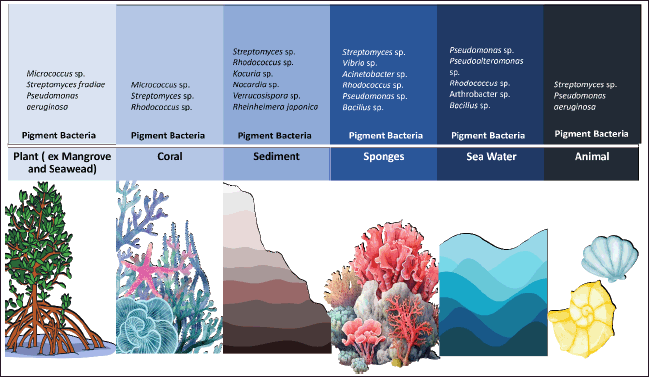 | Figure 1. Marine bacteria source. [Click here to view] |
The Streptomyces genus of marine pigment bacteria is one of the most potential. It is well-recognized that these bacteria are capable of producing a large variety of bioactive substances, such as pigments. For instance, pigments with anticancer characteristics, such as prodigiosin, have been identified as being produced by Streptomyces species. Prodigiosin has bioactive properties such as antibacterial, antiviral, and antioxidant compounds [7,8]. Cyanobacteria are another kind of marine pigment bacteria. These bacteria are well known for their capacity to generate a variety of pigments, such as phycobilin and carotenoids. As an illustration, it has been discovered that certain cyanobacteria could be explored as a cosmetic material. Another illustration is the cyanobacterium Spirulina platensis, which is frequently taken as a nutritional supplement and is well-known for producing colors like phycocyanin and carotenoids [9,10].
The productivity of these pigments is being studied, and techniques like adding natural substances to nutritional media or using gene expression techniques are being used to boost pigment synthesis. To the best of our knowledge, there are not any bibliometric studies available right now that assess the results of research on marine bacterium pigment both statistically and qualitatively. As a result, it is crucial to evaluate the worldwide research profile of the literature on marine bacteria pigment. The goal of this study was to provide a thorough overview of the literature on marine bacteria pigment potential related to the last nine decades by mapping international collaboration, assessing the effectiveness of eminent universities, looking at the output of esteemed journals, analyzing the traits of highly cited articles, and highlighting emerging research topics. The results of this study could help researchers and practitioners assess the impacts of their work by offering a visual summary of the state of the field’s research.
MATERIALS AND METHODS
All papers pertaining to marine bacterium pigment that were published throughout a nine-decade period (1933–2023) were retrieved using the Scopus database. In several fields, Scopus was considered the main resource for bibliometric analysis [11–13]. A bibliometric filter was mined on April, 3rd 2024. To extract papers related to marine pigment bacteria from the Scopus database using the key phrases [“marine” AND “bacteria” AND “pigment”] in the “title” and “abstract” columns. The Scopus database found 955 documents related to marine pigment bacteria. The following information was extracted: document type, publication year, institutions, nations, journal names, citations, and key phrases. The retrieved data were examined using VOSviewer [14].
RESULTS
A total of 955 documents about marine pigment bacteria were published worldwide between 1933 and 2023, translating to an average of 11 documents per year. The majority (n = 829; 86.80%) are research articles, followed by reviews (n = 52; 5.44%), book chapters (n = 32; 3.35%), conference papers (n = 23; 2.40%), data papers, and books, respectively (n = 5; 0.52%), followed by a short survey (n = 3; 0.31%). Similarly, note and conference review (n = 2; 0.20%), as for letter and erratum (n = 1; 0.10%). English represented the majority of the documents (n = 934; 97.80%), with Chinese (n = 6; 0.62%), Korean (n = 5; 0.52%), Spanish, Japanese, and French, respectively (n = 2; 0.20%), as for Ukraine and Portuguese (n = 1; 0.10%) following in order of popularity. Documentation pertaining to marine pigment bacteria has been steadily rising since 1965; the peak production was reached in 2013 (n = 53; 4.26%) (Fig. 3).
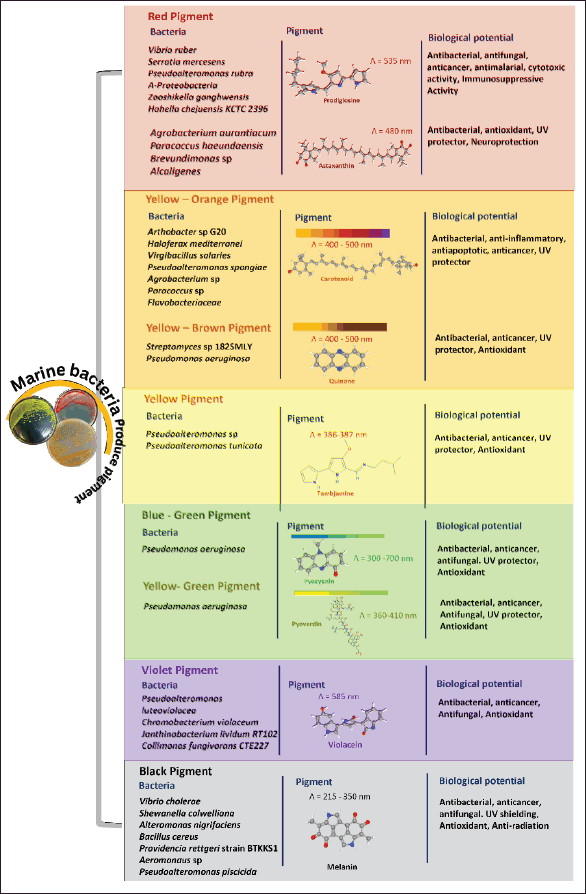 | Figure 2. Biological potential of marine pigment bacteria. [Click here to view] |
69 countries contributed to the body of knowledge about marine pigment bacteria between 1933 and 2023. The United States ranked first with a publication share of 19.16%, while Spain came in at number ten with 4.18%. The top 10 countries in terms of their relative contributions to the total number of documents worldwide are shown in Table 1. With 183 (19.16%) documents created, the United States was the top producer, followed by India (n = 128; 13.4%), China (n = 116; 12.14%), Germany (n = 101; 10.5%), and Japan (n = 97; 10.1%). According to Table 1 and Figure 4, Germany (n = 28) had the most international collaborations, followed by the US (n = 27), France, and the United Kingdom (n = 23).
VOSviewer categorizes the extracted terms into a color gradient from blue to yellow, representing old to new publication years (Figs. 5 and 6). The early years of marine pigment bacteria were published by the US, Korea, Japan, and Australia, followed by other countries such as China, India, and Canada. Recently, the latest research was published by the following countries: Indonesia, Thailand, Portugal, Egypt, and Saudi Arabia. Table 2 shows the highest article citation on Marine Pigment Bacteria and the top ten most popular articles on the Scopus database. The article with the highest citation has been published in Microbiology and Molecular Biology Reviews with citation number 1.109. Most of the publications explain the structure, molecule identification, or isolation methods of marine bacteria’s pigment. Table 2 also highlights significant contributions in the field of marine pigment bacteria research and serves as a resource.
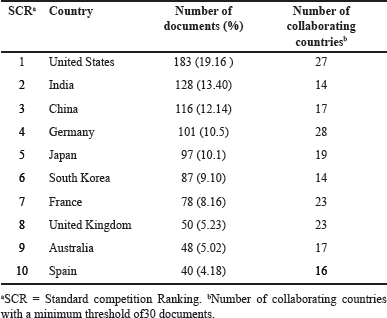 | Table 1. The contribution and collaboration of the world’s ten leading nations in the publication of marine pigment bacteria from 1933 to 2023. [Click here to view] |
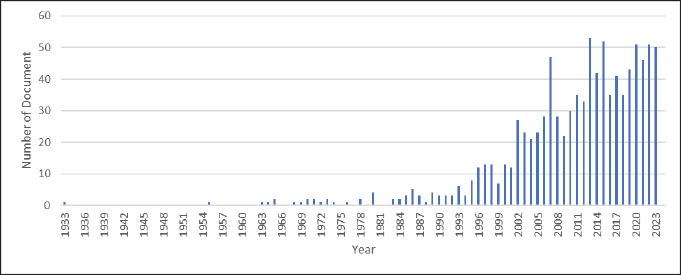 | Figure 3. An overview of research publications about marine pigment bacteria from 1933 to 2023. From the Scopus database, a total of 955 papers were obtained. Since the 1965s, research on marine pigment bacteria has been more productive; in 2013, the greatest number of publications. [Click here to view] |
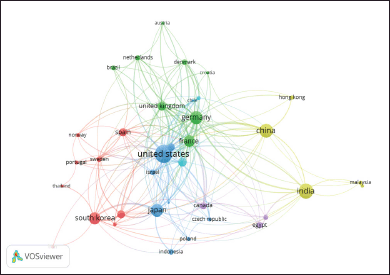 | Figure 4. Mapping countries collaboration. Of the 69 countries, 13 released at least 30 papers. The circle’s size corresponds with the quantity of international partnerships. [Click here to view] |
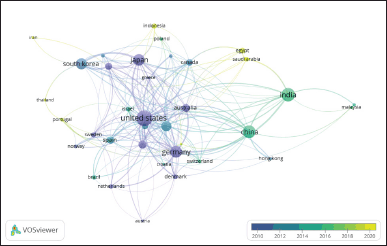 | Figure 5. Visualization of countries with active publications on marine bacterial pigments. (blue indicates old publications, yellow: recent publications). [Click here to view] |
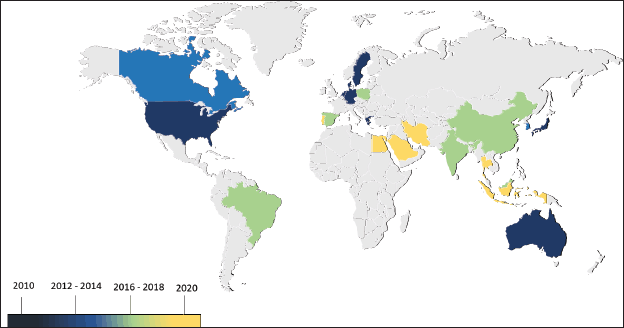 | Figure 6. Map of country distribution of countries with active publications on arine bacterial pigment. [Click here to view] |
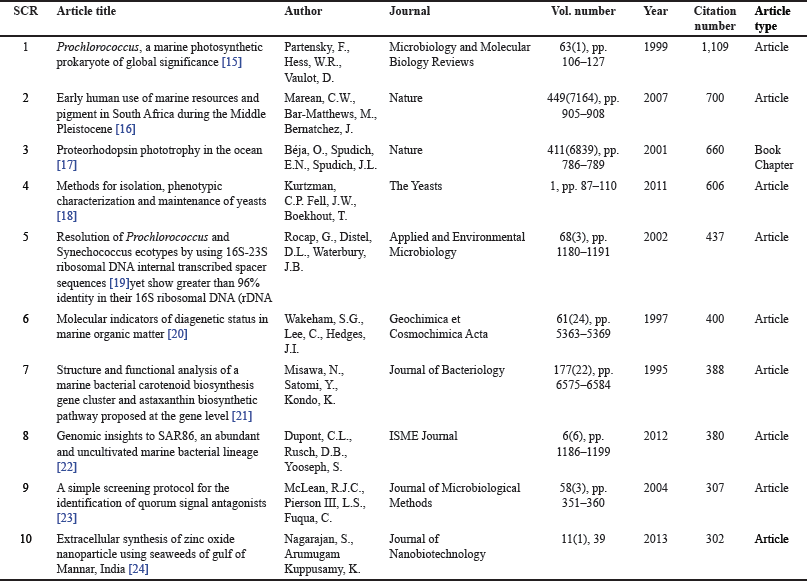 | Table 2. The highest article citation on marine pigment bacteria. [Click here to view] |
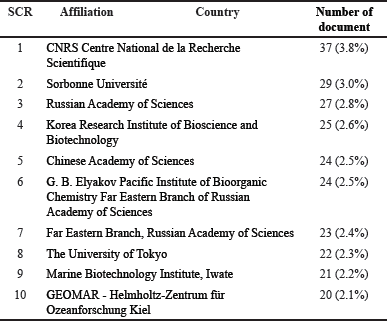 | Table 3. The most productive institutions in publications related to marine pigment bacteria. [Click here to view] |
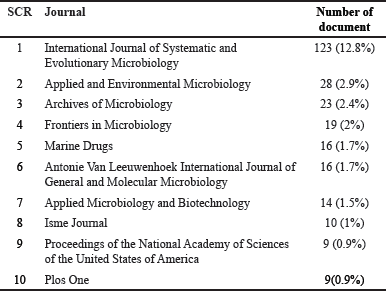 | Table 4. The most popular journal in the field of Marine pigment bacteria. [Click here to view] |
 | Figure 7. Mapping of occurrence terms from VOSviewer generated from abstracts and titles of research publications on pigment marine bacteria. (a) Network visualization. (b) Overlay visualization. [Click here to view] |
Table 3 demonstrates the worldwide performance of the top 10 productive marine pigment bacteria research institutions between 1933 and 2023, with a total of 252 (26.3%) documents. The most frequent contributor, with 37 (3.8%) papers pertaining to marine pigment bacteria, is the CNRS Centre National de la Recherche Scientifique in France. The Sorbonne Université (n = 29; 3%), the Russian Academy of Sciences (n = 27; 2.8%), the Korea Research Institute of Bioscience and Biotechnology (n = 25; 2.6%), the Chinese Academy of Sciences, and the G. B. Elyakov Pacific Institute of Bioorganic Chemistry (the Far Eastern Branch of the Russian Academy of Sciences) has the same number of documents (n = 24; 2.5%). Far Eastern Branch (n = 23; 2.4%), The University of Tokyo (n = 22; 2.3%), Marine Biotechnology Institute, Iwate (n = 21; 2.2%), and GEOMAR Helmholtz–Zentrum für Ozeanforschung Kiel (n = 20; 2.1%) have a sequential number of publications.
Table 4. demonstrates the top ten journals with the most papers globally, with a total of 267 (27.9%) documents. The most often published journals on marine pigment bacteria were the International Journal of Systematic and Evolutionary Microbiology (n = 123; 12.8%), Applied and Environmental Microbiology (n = 28; 2.9%), and Archives of Microbiology (n = 23; 2.4%).
Figure 7 maps the occurrence of terms retrieved from 955 documents related to pigment marine bacteria, resulting in 3 distinguished clusters: red, blue, and green (Fig. 7a). Cluster 1 (red color) includes terms such as phenotype bacteria, bacteria isolation, DNA bacterial, 16S rRNA, phylogeny, sequence analysis, and so on; cluster 2 (green color): bacterial culture, antimicrobial activity, a marine bacterium, marine environment, algae, antioxidants, metabolism, cyanobacteria, carotenoid, chemistry; cluster 3 (blue color): seawater, microbiology, genetics, molecule genetics, DNA sequence, classification. In Figure 7b, VOSviewer categorizes the extracted terms into a color gradient from blue to yellow, representing old to new publication years. The early years of marine pigment bacteria studies elaborated on several key terms such as bacterium isolation, pigment, sequence homology, and marine biology. Meanwhile, the emerging topics in recent years include antimicrobials, antioxidants, marine bacteria, and sequence analysis.
DISCUSSION
The present investigation conducted a comprehensive review of the literature on marine pigment bacteria from around the world. Our results indicate that for the past nine decades, scientists from all over the world have shown a great deal of interest in pigment marine bacteria. Due to the discovery of new species of pigmented bacteria and the growing interest in marine biology, the number of publications about marine pigment bacteria was raised in 1963. The discovery of novel methods and procedures for isolating and describing marine bacteria, as well as the realization of the organisms’ potential uses in a variety of industries, including biotechnology and medicine, probably contributed to this spike in publications [25,26]. The development of new research vessels, submersibles, and other technology that allowed scientists to explore and study the ocean in greater depth contributed to major advancements in the area of marine biology in the 1960s. As a result, the richness of marine life was better understood, and new kinds of bacteria that generated pigments were found [25,27]. The 1963 publication in the “Journal of Marine Research” outlines the rates and potential mechanisms of pigment degradation in phytoplankton-derived detritus that is reliant on light. This demonstrates the increasing interest in marine pigment bacteria during this time [28]. Increased publications related to marine pigment bacteria experienced a significant increase in 2007. This is because the global trade in natural-derived pigments has increased by 29% and reached $600 million from 2007 to 2011 [29]. The publication peak occurred in 2013 (Fig. 3). It is been rotated by the publication “Bioactive Pigments from Marine Bacteria: Applications and Perspectives” in 2011, which highlights the potential applications of marine pigments in various fields, including biotechnology, cosmetics, and pharmaceuticals [26]. So, research related to the development of marine bacteria in the fields of medicine and health is increasingly being carried out, for example, its use in the fields of antibacterials, antivirals, and its use as an anticancer [30,31]. A total of 499 (52.25%) papers were published between 2013 and 2023, averaging 50 documents annually. This suggests a low level of research productivity on the subject of marine pigment bacteria in recent years.
The results show that the country with the most publications related to marine pigment bacteria is the US, with 19.16%, or 183 documents (Table 1). Because of its robust infrastructure for research, availability of financing, and concentration of highly esteemed research institutions and colleges, the United States has produced the greatest number of publications pertaining to marine pigment bacteria. The nation’s high publishing rate is largely due to its research culture, which places a strong emphasis on entrepreneurship, innovation, and teamwork. Furthermore, American research in marine biology and microbiology has a long history, which has contributed to the country’s high publication rate in marine pigment bacteria. With an emphasis on creating ecologically friendly and sustainable technology, the nation’s economic and environmental concerns also motivate research on marine pigment bacteria [1,32]. China and India are also countries that are actively publicizing the field of marine pigment bacteria. The strategic objective of China to grow its marine biotechnology sector, the demand for environmental substitutes for synthetic pigments, and the pursuit of unique and natural bioactive chemicals are the driving forces behind the country’s active research in marine pigment bacteria [1,33]. Evidently, China is home to 3 of the 10 universities with the most publications related to marine pigment bacteria (Table 3). Some countries are also just starting to contribute to marine pigment bacteria research, such as Portugal, Saudi Arabia, and Indonesia (Fig. 5). According to the search findings, Indonesia has a large marine area (81% of the country’s total area) with significant potential for marine bacterial biodiversity. However, little is known about marine bacteria in Indonesia, particularly in the country’s east, which is one of the world’s hotspots for biodiversity [34]. The findings also demonstrate the antibacterial properties of bacteria linked to marine sea slugs from Indonesia’s North Sulawesi. Numerous bacterial strains, including Vibrio and Pseudoalteromonas, that exhibited antibacterial activity against different microorganisms were obtained during the investigation [35]. Our findings also show that a comparatively large proportion of research publications were published in developing countries, suggesting that studies on marine pigment bacteria are not exclusive to wealthy nations. When considered collectively, these results indicate that research on marine pigment bacteria is currently becoming more international in scope.
Early research on marine pigment bacteria defined a number of important concepts, including pigment, sequence homology, bacterium isolation, and marine biology (Fig. 7). Early marine pigment bacteria research focused on the search for marine pigment bacteria and on discovering the species of bacteria. Thus, homologous phenotypes, DNA sequencing, bacterial isolation, and so on, were the main topics of prior research. This is due to the fact that marine pigment bacteria are still poorly understood, making it essential to look into and describe any newly discovered marine bacteria [1,36–43]. Initial research also investigated the isolation of marine bacteria in a laboratory environment and how to grow and maintain their pigments [38,40,41,44]. The research then focused on the isolation and identification of pigments produced by marine bacteria, including carotenoids (yellow-orange), violacein (purple), prodigiosine (red), pyocyanin (green), and melanin (black) [1,4,10,33]. The latest research development related to marine pigment bacteria is the exploration of bioactive pigment compounds that have potential as antibacterial, antiviral, and anticancer [4,8,31,45]. Currently, the research trend is referring to the exploration of antibacterial activity against pathogenic bacteria [1,3,4,6,29,33,34,43–46]. Bioactive compounds found in pigmented marine bacteria are considered to be able to serve as an alternative to nature to become promising antibacterial compounds.
FUTURE PERSPECTIVE
Potential uses for marine pigment bacteria in biotechnology, medicine, and cosmetics are promising in the future. The need for improved screening techniques, extraction procedures, and efficient downstream processing are some of the issues that must be solved.
CONCLUSION
Investigations into the possible uses of marine pigment bacteria in biotechnology, medicine, and cosmetics are likely to be fruitful in the future. There have been more publications on marine pigment bacteria as a result of both the discovery of new species and the increased interest in marine biology. New pigmented bacteria have been discovered and a better understanding of marine life has resulted from scientists’ ability to study and explore the ocean at greater depths thanks to the development of new research vessels and technologies. Driven by the need for sustainable and eco-friendly substitutes for synthetic pigments, the use of marine pigment bacteria as a source of natural colorants, antioxidants, and antimicrobial compounds is growing in popularity.
AUTHOR CONTRIBUTIONS
All authors made substantial contributions to conception and design, acquisition of data, or analysis and interpretation of data; took part in drafting the article or revising it critically for important intellectual content; agreed to submit to the current journal; gave final approval of the version to be published; and agree to be accountable for all aspects of the work. All the authors are eligible to be an author as per the International Committee of Medical Journal Editors (ICMJE) requirements/guidelines.
FINANCIAL SUPPORT
There is no funding to report.
CONFLICTS OF INTEREST
The authors report no financial or any other conflicts of interest in this work.
ETHICAL APPROVALS
This study does not involve experiments on animals or human subjects.
DATA AVAILABILITY
All data generated and analyzed are included in this research article.
PUBLISHER’S NOTE
This journal remains neutral with regard to jurisdictional claims in published institutional affiliation.
REFERENCES
1. Velmurugan P, Venil CK, Veera Ravi A, Dufossé L. Marine bacteria is the cell factory to produce bioactive pigments: a prospective pigment source in the ocean. Front Sustain Food Syst. 2020;4:1–7. CrossRef
2. Stincone P, Brandelli A. Marine bacteria as source of antimicrobial compounds. Crit Rev Biotechnol. 2020;40:306–19. CrossRef
3. Chaudhary R, Shah Z, Fouillaud M, Mukhtar H. Applications of Bio-Pigments Synthesized by Marine Bacteria n.d.
4. Nawaz A, Chaudhary R, Shah Z, Dufossé L, Fouillaud M, Mukhtar H, et al. An overview on industrial and medical applications of bio-pigments synthesized by marine bacteria. Microorganisms 2021;9:1–24. CrossRef
5. Prastiyanto ME, Darmawati S, Daryono BS, Retnaningrum E. Black-pigmented marine pseudomonas aeruginosa exhibiting anti-bacterial activity against multidrug-resistant (MDR) wound infection bacteria. Hayati J Biosci. 2024;31:880–90. CrossRef
6. Prastiyanto ME, Darmawati S, Daryono BS, Retnaningrum E. Antibacterial activity of yellow pigment from Micrococcus flavus AK 11 isolates of the coral porites sp. from Gosong Beach, Central Java, Indonesia. Egypt J Aquat Biol Fish. 2024;28:723–37.
7. Abraham J, Chauhan R. Profiling of red pigment produced by Streptomyces sp. JAR6 and its bioactivity. 3 Biotech. 2018;8:1–9. CrossRef
8. Ibrahim WM, Olama ZA, Abou-elela GM, Ramadan HS, Hegazy GE, El Badan DES. Exploring the antimicrobial, antiviral, antioxidant, and antitumor potentials of marine Streptomyces tunisiensis W4MT573222 pigment isolated from Abu-Qir sediments, Egypt. Microb Cell Fact 2023;22:1–17. CrossRef
9. Saini DK, Pabbi S, Shukla P. Cyanobacterial pigments: perspectives and biotechnological approaches. Food Chem Toxicol 2018;120:616–24. CrossRef
10. Pagels F, Guedes AC, Vicente AA, Vasconcelos V. Cyanobacteria-based bioprocess for cosmetic products—cyanobium sp. as a novel source of bioactive pigments. Phycology 2023;3:47–64. CrossRef
11. Kulkarni AV, Aziz B, Shams I, Busse JW. Comparisons of citations in web of science,. Jama 2009;302:1092–6.
12. Falagas ME, Pitsouni EI, Malietzis GA, Pappas G. Comparison of PubMed, scopus, web of science, and google scholar: strengths and weaknesses. FASEB J 2008;22:338–42. CrossRef
13. Burnham JF. Scopus database: a review. Biomed Digit Libr 2006;3:1–8. CrossRef
14. Sofyantoro F, Yudha DS, Lischer K, Nuringtyas TR, Putri WA, Kusuma WA, et al. Bibliometric Analysis of Literature in Snake Venom-Related Research Worldwide (1933–2022). Animal 2022;12:2058. https://doi.org/10.3390/ani12162058.
15. Partensky F, Hess WR, Vaulot D. Prochlorococcus, a marine photosynthetic prokaryote of global significance. Microbiol Mol Biol Rev. 1999;63:106–27. CrossRef
16. Marean CW, Bar-Matthews M, Bernatchez J, Fisher E, Goldberg P, Herries AIR, et al. Early human use of marine resources and pigment in South Africa during the Middle Pleistocene. Nature 2007;449:905–8. CrossRef
17. Béja O, Spudich EN, Spudich JL, Leclerc M, DeLong EF. Proteorhodopsin phototrophy in the ocean. Nature 2001;411:786–9. CrossRef
18. Kurtzman CP, Fell JW, Boekhout T, Robert V. Methods for isolation, phenotypic characterization and maintenance of yeasts. Amsterdam, The Netherlands: Elsevier B.V.; 2011. vol. 1. CrossRef
19. Rocap G, Distel DL, Waterbury JB, Chisholm SW. Resolution of prochlorococcus and synechococcus ecotypes by using 16S-23S ribosomal DNA internal transcribed spacer sequences. Appl Environ Microbiol. 2002;68:1180–91. CrossRef
20. Wakeham SG, Lee C, Hedges JI, Hernes PJ, Peterson ML. Molecular indicators of diagenetic status in marine organic matter. Geochim Cosmochim Acta. 1997;61:5363–9. CrossRef
21. Misawa N, Satomi Y, Kondo K, Yokoyama A, Kajiwara S, Saito T, et al. Structure and functional analysis of a marine bacterial carotenoid biosynthesis gene cluster and astaxanthin biosynthetic pathway proposed at the gene level. J Bacteriol 1995;177:6575–84. CrossRef
22. Dupont CL, Rusch DB, Yooseph S, Lombardo MJ, Alexander Richter R, Valas R, et al. Genomic insights to SAR86, an abundant and uncultivated marine bacterial lineage. ISME J. 2012;6:1186–99. CrossRef
23. McLean RJC, Pierson LS, Fuqua C. A simple screening protocol for the identification of quorum signal antagonists. J Microbiol Methods 2004;58:351–60. CrossRef
24. Nagarajan S, Arumugam Kuppusamy K. Extracellular synthesis of zinc oxide nanoparticle using seaweeds of gulf of Mannar, India. J Nanobiotechnol. 2013;11:1–11. CrossRef
25. Nelson JR. Rates and possible mechanism of light-dependent degradation of pigments in detritus derived from phytoplankton. J Mar Res. 1993;51:155–179. doi: 10.1357/0022240933223837.
26. Soliev AB, Hosokawa K, Enomoto K. Bioactive pigments from marine bacteria: applications and physiological roles. Evid-Based Complement Alternative Med 2011;2011:670349. CrossRef
27. Setiyono E, Adhiwibawa MAS, Indrawati R, Prihastyanti MNU, Shioi Y, Brotosudarmo THP. An Indonesian marine bacterium, Pseudoalteromonas rubra, produces antimicrobial prodiginine pigments. ACS Omega 2020;5:4626–35. CrossRef
28. Persons T, Strickland JD. Discussion of spectrophotometric determination marine-plant pigments, with revised of equations for ascertaining carotenoids chlorophylls and carotenoids. Fish Res Board Canada 1963:155–9.
29. Sajjad W, Din G, Rafiq M, Iqbal A, Khan S, Zada S, et al. Pigment production by cold-adapted bacteria and fungi: colorful tale of cryosphere with wide range applications. Extremophiles 2020;24:447–73. CrossRef
30. Manochkumar J, Doss CGP, Efferth T, Ramamoorthy S. Tumor preventive properties of selected marine pigments against colon and breast cancer. Algal Res 2022;61:1–6. CrossRef
31. Srilekha V, Krishna G, Seshasrinivas V, Charya M. Antibacterial and anti-inflammatory activities of marine Brevibacterium sp. Res Pharm Sci 2017;12:283–9. CrossRef
32. Venil CK, Dufossé L, Renuka Devi P. Bacterial pigments: sustainable compounds with market potential for pharma and food industry. Front Sustain Food Syst 2020;4:1–17. CrossRef
33. Azman AS, Mawang CI, Abubakar S. Bacterial pigments: the bioactivities and as an alternative for therapeutic applications. Nat Prod Commun. 2018;13:1747–54. CrossRef
34. Tapilatu YH. Marine bacteria from Eastern Indonesia waters and their potential use in biotechnology. Omni-Akuatika 2016;12:81–5. CrossRef
35. Böhringer N, Fisch KM, Schillo D, Bara R, Hertzer C, Grein F, et al. Antimicrobial potential of bacteria associated with marine sea slugs from North Sulawesi, Indonesia. Front Microbiol. 2017;8:1–8. CrossRef
36. Lozano C, Kielbasa M, Gaillard JC, Miotello G, Pible O, Armengaud J. Identification and characterization of marine microorganisms by tandem mass spectrometry proteotyping. Microorganisms 2022;10:719. CrossRef
37. Marzuki I, Kamaruddin M, Ahmad R. Identification of marine sponges-symbiotic bacteria and their application in degrading polycyclic aromatic hydrocarbons. Biodiversitas 2021;22:1481–8. CrossRef
38. Sangeetha D, Tharani J, Ishwarya R, Ramya P. Isolation and screening of marine bacterial isolates against clinical pathogens. Int J Curr Pharm Res 2022;14:53–7. CrossRef
39. Oliver JD. Taxonomic scheme for the identification of marine bacteria and GIBBONS, 1974. Also used in preparing the schemes was information reported in studies. Limnology 1982;29:1975–8.
40. Rodrigues CJC, de Carvalho CCCR. Cultivating marine bacteria under laboratory conditions: Overcoming the “unculturable” dogma. Front Bioeng Biotechnol 2022;10:1–14. CrossRef
41. Mohamed SS, Abdelhamid SA, Ali RH. Isolation and identification of marine microbial products. J Genet Eng Biotechnol 2021;19:1–10. CrossRef
42. Christensen A, Martin GDA. Identification and bioactive potential of marine microorganisms from selected Florida coastal areas. Microbiologyopen 2017;6:1–10. CrossRef
43. da Silva MAC, Cavalett A, Spinner A, Rosa DC, Jasper RB, Quecine MC, et al. Phylogenetic identification of marine bacteria isolated from deep-sea sediments of the eastern South Atlantic Ocean. Springerplus 2013;2:1–10. CrossRef
44. Rodrigues CJC, Pereira RFS, Fernandes P, Cabral JMS, de Carvalho CCCR. Cultivation-based strategies to find efficient marine biocatalysts. Biotechnol J 2017;12:1–10. CrossRef
45. Rahman H, Austin B, Mitchell WJ, Morris PC, Jamieson DJ, Adams DR, et al. Novel anti-infective compounds from marine bacteria. Mar Drugs 2010;8:498–518. CrossRef
46. Muñoz-Miranda LA, Iñiguez-Moreno M. An extensive review of marine pigments: sources, biotechnological applications, and sustainability. Aquat Sci 2023;85. CrossRef